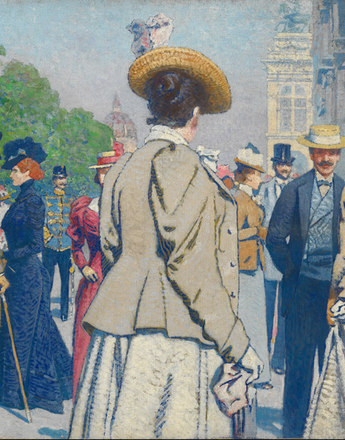“Lay down your arms” – Bertha von Suttner, the most prominent Austrian peace activist
Bertha von Suttner was born Countess Kinsky von Wchinic und Tettau in Prague on 9 June 1843. Her father, Count Franz Michael Kinsky, field marshal in the Austro-Hungarian army, died at the age of 75 before she was born. As a result, Bertha von Kinsky was brought up by her mother (née Körner). The Kinsky family was one of the most prominent Bohemian aristocratic dynasties, and Bertha von Kinsky thus received the education of a young lady in aristocratic circles. Apart from German, she learnt French, English and Italian. She also received piano lessons and read classical literature.
She first came into contact with militarism, war and peace with her husband Arthur in Paris in the winter of 1886/87, when she met Alfred Nobel. A year earlier the couple had returned from a nine-year stay in the Caucasus, where Bertha von Suttner has written a draft for her first novel. Alfred Nobel, renowned as the inventor of dynamite, was looking at the question of war and of ways of preventing it. He was convinced, for example, that lasting peace could be achieved only through the invention of a weapon of mass destruction that would be so devastating that humanity would be deterred for ever from waging war.
Through Alfred Nobel’s circle Bertha von Suttner learned for the first time of the existence of European peace movements and came into contact with pacifist ideas. She published her first novel, Das Maschinenalter, in 1887 under the pseudonym ‘Jemand’. It was based on her own experience in the Russo-Turkish war of 1877, which she had witnessed in the Caucasus. Her second work, Lay Down Your Arms, appeared two years later. Like Suttner, the aristocratic protagonist of this novel came from a family with a military background. Her life, which is narrated in the book, was marked again and again by death and suffering as a result of war. The book was a resounding success and remains her most well-known work. By 1917 it had been reprinted forty times in German and translated into sixteen languages.
Translation: Nick Somers
Cohen, Laurie R. (Hrsg.): „Gerade weil Sie eine Frau sind …“ Erkundungen über Bertha von Suttner, die unbekannte Friedensnobelpreisträgerin, Wien 2005
Gütermann, Christoph: Die Geschichte der österreichischen Friedensbewegung 1891-1985, in: Rauchensteiner, Manfried (Hrsg.): Überlegungen zum Frieden, Wien 1987, 13-132
Hamann, Brigitte: Bertha von Suttner – Ein Leben für den Frieden, München 2002
Kovács, Henriett: Die Friedensbewegung in Österreich-Ungarn an der Wende zum 20. Jahrhundert, Mitteleuropäische Studien II, herausgegeben von Binder, Dieter A./Kastner, Georg/Suppan, Arnold, Herne 2009
Quotes:
„[...] that lasting peace could be achieved …“: Kovács, Henriett: Die Friedensbewegung in Österreich-Ungarn an der Wende zum 20. Jahrhundert, Mitteleuropäische Studien II, herausgegeben von Dieter A. Binder/Georg Kastner/Arnold Suppan, Herne 2009, 16
„By 1917 it had been reprinted …“: figures, quoted from: Cohen, Laurie R. (Hrsg.): „Gerade weil Sie eine Frau sind …“ Erkundungen über Bertha von Suttner, die unbekannte Friedensnobelpreisträgerin, Wien 2005, 47
Biographical data of Bertha von Suttner from: Cohen, Laurie R. (Hrsg.): „Gerade weil Sie eine Frau sind …“ Erkundungen über Bertha von Suttner, die unbekannte Friedensnobelpreisträgerin, Wien 2005 und Kovács, Henriett: Die Friedensbewegung in Österreich-Ungarn an der Wende zum 20. Jahrhundert, Mitteleuropäische Studien II, herausgegeben von Dieter A. Binder/Georg Kastner/Arnold Suppan, Herne 2009, 13 ff
-
Chapters
- “Lay down your arms” – Bertha von Suttner, the most prominent Austrian peace activist
- ‘The Austrian Society of Friends of Peace’– a brief episode?
- Alfred H. Fried and the peace movement during the war – censorship and derision
- ‘The League of Austrian Women’s Associations’ and the end of peace activities
- The Hague or the “betrayal” of the warring nation
- ‘… and tomorrow we will start cheerily canvassing for peace.’
- Peace and social issues
- The idea of the ‘peace-loving woman’?
- Peace and the Church – Thou shalt not kill!
- Peace and language – peace and the Esperanto movement
- Para Pacem – an Austrian peace movement with a difference
- Individual peace initiatives – Julius Meinl and Heinrich Lammasch
- ‘… surely this war must end some time?!’






